Background: Prostate Cancer is a major Public Health problem because of its high incidence and mortality. It is feared by men due to negative stigma brought by its diagnosis and its psychological effects, which affect the perception of sexuality and their own personal image and thereby affect the quality of life. The aim of the study was to investigate the health-related quality of life and associated factors of patients receiving radiotherapy treatment for prostate cancer at the Cancer Diseases Hospital in Lusaka, Zambia.
Materials and Methods: A cross-sectional analytical study design was carried out in a specialized unit of Cancer Diseases Hospital in Lusaka Zambia with a census sample of 51 men with prostate cancer, who were on radiotherapy (all the 51 men who were on radiotherapy treatment for prostate cancer were included). Questionnaires were administered to participants who could read and understand, while an interview schedule was used for those who were unable to read and understand. Participants recruited in the study included all men aged 40 and above clinically diagnosed with prostate cancer and receiving radiotherapy treatment at any stage of the disease and have had atleast three sessions of radiotherapy. This study was conducted between 2022 March -2023 August, data was collected using the validated World Health Organization Quality of life- Bref (WHOQOL-100) tool and SPSS version 26 was used to analyze data. The WHOQOL-BREF questionnaire contained a total of 26 items and 3 items on the factor associated. These items covered various aspects of an individual's quality of life, including physical health, psychological well-being, social relationships, and the environment. Each item corresponds to a specific aspect of quality of life and was scored on a scale from 1 to 5, with 1 representing the lowest level of satisfaction or well-being and 5 representing the highest level.
Results: Results showed that majority (82%) of the participants had a poor Health-Related Quality of Life, while only 9 (18%) had good quality of life. The results indicated that age was not a significant predictor of HRQoL. However, when analyzing age by groups, patients aged 66-75 years and 76-85 years had significantly lower odds of good HRQoL when compared to those aged 40-55 years in the univariate analysis (66-75 years p=0.068 and 76-85 years p=0.041). Nonetheless, in the multivariable analysis, age was not found to be a significant predictor of HRQoL.
The duration of radiotherapy was also found to be significantly associated with HRQoL. Patients who received radiotherapy for a duration of 3-4 weeks and above 4 weeks had lower odds of good HRQoL compared to those who received radiotherapy for less than 3 weeks (3-4 weeks p=0.064 and above 4 weeks p=0.034). The dosage of radiotherapy was also a significant predictor of HRQoL. Patients who received a dosage of 31-50 grays and above 50 grays had lower odds of good HRQoL compared to those who received a dosage of 30 grays or less (31-50 grays p=0.067 and above 50 grays p=0.045). Furthermore, the stage of the disease was also found to be significantly associated with HRQoL. Patients with stage 2 cancer (p=0.025) and stage 3 and above (p=0.002) had lower odds of good HRQoL compared to those with stage 0 cancer (stage 2 cancer p=0.025 and stage 3 and above p=0.002).
Conclusion: The study concluded that there is poor Health-Related Quality of Life (HRQoL) of prostate cancer patients undergoing radiotherapy at the Cancer Diseases Hospital in Lusaka, Zambia. Therefore, it is recommended that interventions be prioritized to improve HRQoL of prostate cancer patients. Multidimensional interventions that address physical, social, environmental, and psychological domains of HRQoL should be considered. Additionally, the impact of age, radiotherapy duration on radiotherapy, dosage of radiotherapy, and stage of the disease on HRQoL should be taken into consideration when designing interventions to improve HRQoL in prostate cancer patients.
Keywords: Health related quality of life, Prostate cancer and radiotherapy
Cancer is a leading cause of death worldwide, accounting for 9.9 million translating into 15% of all deaths that occurred in 2020.1 The World Health Organization (WHO) further notes that more than 60% of all cancers occur in middle- and low-income countries and these regions alone account for 70% of the world's cancer-related deaths.1 In men, prostate cancer has been reported to be the most common cancer diagnosed globally while in Africa, prostate cancer accounts for 18% of all total cases.2,3 A diagnosis of prostate cancer and its subsequent treatment are sources of stress and anxiety, which affect not only the patients’ health, but also their daily functioning and social life. In addition, mood and cognitive disorders may develop.3,4 Both physical and psychological symptoms can negatively affect the quality of life (QoL) of Prostate cancer patients.
Health-related quality of life is a multidimensional construct that typically includes four broad categories: physical, functional, social, and emotional well-being. Cella states that Health-related quality of life refers to the extent to which one’s usual or expected physical, social and emotional well-being are affected by a medical condition or its treatment.5 Thus, the minimum criteria for appropriate measurement of Health-related quality of life include (a) that measurement incorporates the patient’s perspective and (b) that it captures physical, social, and mental well-being.
In Zambia, the number of prostate cancer patients seen at Cancer Diseases Hospital is increasing steadily from 144 in 2019 to 240 in 2021 (HMIS, 2022). Radiotherapy treatment is one of the major treatment options been used in the treatment of prostate cancer patients in Zambia. The use of Radiotherapy has contributed to an increase in the number of prostate cancer survivors in Zambia (MOH Report). While radiotherapy aims to prolong patient survival, anecdotal data from healthcare workers at the Cancer Diseases Hospital suggests that patients undergoing radiotherapy have reported problems that may lead to a low HRQOL, potentially counteracting the objective of radiotherapy.6,7
The most-reported problems that PCa patients on radiotherapy encounter are urinary incontinence (the inability to control the bladder) and erectile dysfunction (the inability to achieve a full erection) anxiety, psychological distress, social concerns, and depression.8,9 These potential changes can impact one’s self-esteem and personal relationships which may affect the health-related quality of life of a patient. Therefore, this study aimed to investigate the health-related quality of life of patients receiving radiotherapy treatment for prostate cancer at the Cancer Diseases Hospital.
Study design and setting
The cross-sectional analytical study design was selected for this study. The study was conducted at the country's sole Cancer Diseases Hospital (CDH) in Lusaka, Zambia, which served as the location for establishing the health-related quality of life among prostate cancer patients on radiotherapy treatment. Additionally, the site was conveniently located and easily accessible, allowing for efficient data collection.
Study Population and Sample
The population for this study consisted of clinically diagnosed prostate cancer patients who were undergoing radiotherapy treatment and had undergone atleast three sessions of Radiotherapy at Cancer Diseases Hospital in Lusaka, Zambia. The census method of sampling was used for the study, as data was collected from every member of the population, which consisted of 51 participants (HMIS, 2022).
Data Collection and Analysis
A structured interview was conducted using the validated World Health Organization Quality of life-Bref (WHOQOL-100) tool to collect data on quality of life. Questionnaires were administered to participants who could read and understand, while an interview schedule was used for those who were unable to read and understand. The HRQOL PCa scores were analyzed using SPSS version 26 and responses and outcomes were coded and made into binary outcomes, for which frequencies and percentages were calculated. Frequency tables, cross-tabulation tables, and graphs were used for data presentation. Chi-square tests were done to test for associations between categorical variables. Binary logistic regression analysis was performed to identify associations to HRQOL because variables were categorical.10
Section 1
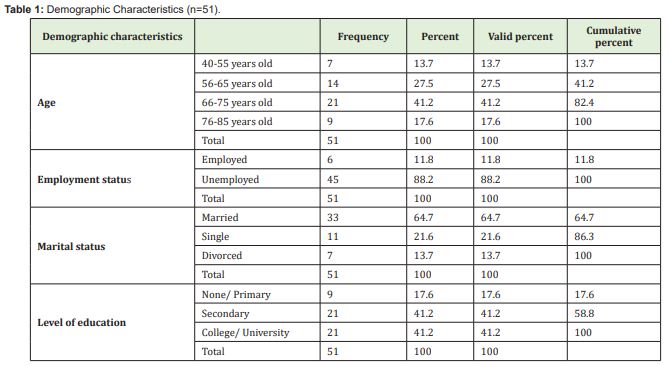
Majority of participants were in the age range of 66-75 years old (41.2%), majority of the participants were unemployed (88.2%), most participants were married (64.7%),and majority of participants had completed secondary education (41.2%) or college/university education (41.2%).
Section 2
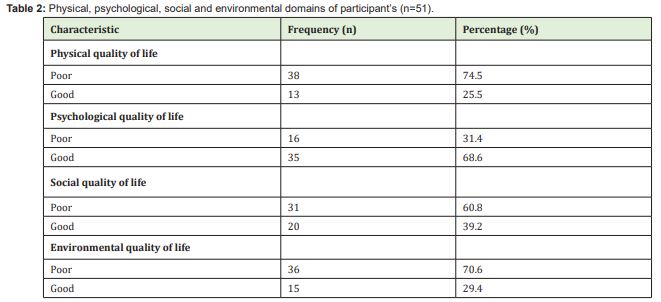
The scores of each domain were aggregated and adjusted according to scoring guidelines provided for in the tool then dichotomised (poor/good) based on a 50 percent cut–off.
The results showed that most participants had poor physical (74.5%), social (60.8%), and environmental (70.6%) quality of life. However, the majority of participants reported good psychological quality of life (68.6%).
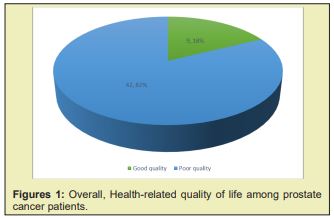
Majority 42 (82%) of the participants had a poor health-related quality of life, with only a minority 9 (18%) having good quality of life.
Section 3
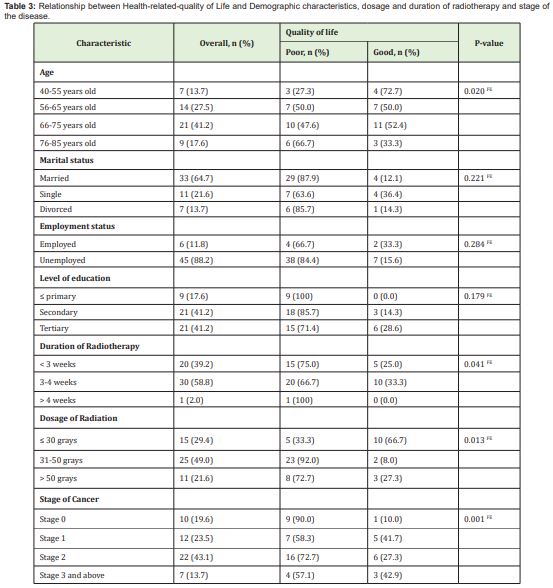
The results showed that age, duration of radiotherapy, dosage of radiation, and stage of cancer are factors significantly associated with the reported quality of life. Other demographic factors like marital status, employment status, and level of education also showed some variations in quality of life but were not statistically significant in this specific study.
Section 4, Assessment of each domain
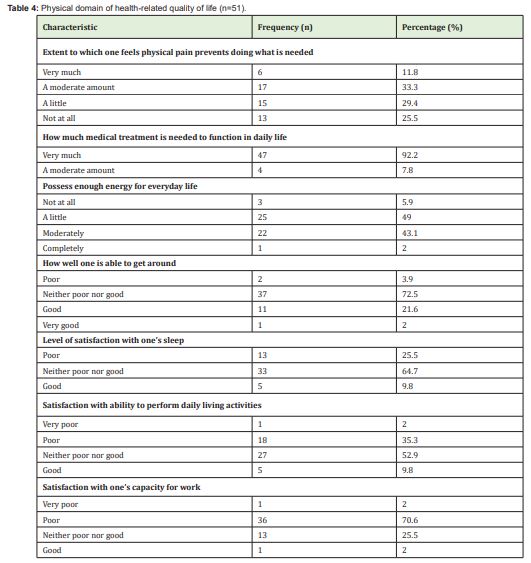
These results suggest that there are significant physical health issues affecting the participants in this survey, particularly with respect to pain, the need for medical treatment, and energy levels, as well as some limitations in daily activities and work capacity.
Assessment of the psychological domain of health-related quality of life (n=51)

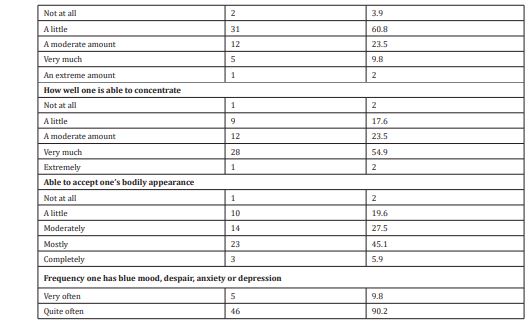
The results indicate that the majority of participants reported enjoying life to a moderate extent, feeling that their life was at least a little meaningful, and being able to concentrate very much. Additionally, most participants were able to accept their bodily appearance, with 45.1% reporting feeling mostly able to do so. However, a significant proportion of participants reported experiencing blue moods, despair, anxiety, or depression quite often (90.2%).
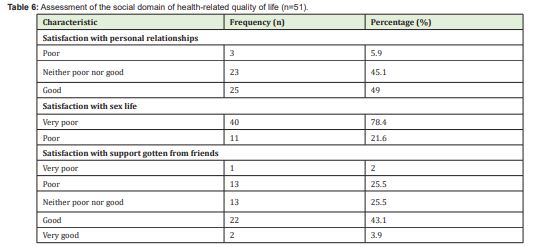
Results show that majority of the participants 78.4% reported very poor satisfaction with their sex life, while 21.6% reported poor satisfaction. And majority was satisfied with personal relationships and support from friends.

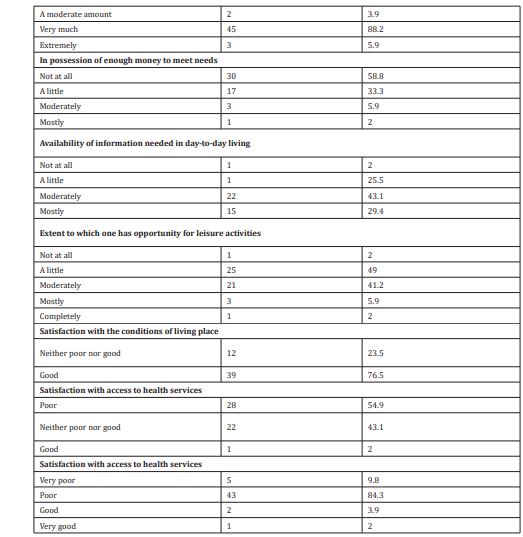
Access to health services, social support and money to meet their needs were areas of concern, with a majority reporting poor access to health services and social support and not having enough money to meet their needs.
Section 4
Binary logistic regression analysis of factors associated with HRQoL

The study identified several factors that were statistically associated with HRQoL among prostate cancer patients. These factors included duration and dosage of radiotherapy, and the stage of the disease.
Age was not found to be significantly associated with health-related quality of life (HRQoL) in the overall analysis. However, when analyzing the data by age group, it was observed that patients aged 66-75 and 76-85 years had significantly lower odds of good HRQoL compared to those aged 40-55 years in the Univariate analysis. This suggests that age may have an effect on HRQoL, but other factors may also be involved.
Characteristics of the study sample
The study sample consisted of 51 men aged 40 and above clinically diagnosed with prostate cancer on Radiotherapy and had received atleast three sessions of radiotherapy. The important socio demographic characteristics in this study included age, marital status, employment status, and level of Education (Table 1). The results showed that the majority of participants were in the range of 66-75 (41.2%) years old. This finding is in support with the study that was conducted by Chen who reported that majority of the participants were aged 65 years and above. The study found that majority were married and only a minority were not married (single 11(21.6) and divorced 7(13.7)), the unmarried participants had lower odds of reporting good quality of life as compared to the married, this suggests that being married may have some positive effects on the quality of life of prostate cancer patients, as compared to being single or divorced. This finding is in contrast with that of found that the majority of the respondents (61%) were single. These disparities in the results could be due to different environmental and social factors.11
The study found that the unemployment rate among the participants was high, with 88.2% being unemployed. Findings of this study were in line with that of Buaocham who found that 78% of his study participants in Uganda were unemployed,11 while Ijoma found that 90% of their study participants in Nigeria were unemployed. The high unemployment rate among prostate cancer patients may be attributed to various factors, such as the advanced age of the patients and the disease itself. Prostate cancer is more prevalent in older men, and as a result, many of the patients may already be retired or nearing retirement age. Additionally, the disease may also lead to physical limitations and complications that may make it difficult for patients to continue working. These factors can contribute to the high unemployment rate among prostate cancer patients.
Most of the participants attained secondary (41.2%) and tertiary (41.2%) education. The study also found that those who had attained only primary education or none at all were more likely to present to the hospital when the disease had already progressed to an advanced stage. This may be due to a lack of awareness about the disease or its symptoms, as well as limited access to healthcare services for those with lower levels of education and socioeconomic status. This finding suggests that education maybe a barrier to seeking medical attention for prostate cancer patients in Zambia. Similarly, Abdelhafez found that 62% of their study participants had attained at least secondary or tertiary education. These findings indicate that some social and demographic characteristics in the population may negatively contribute to the Quality of life of a patient.
Health-related quality of life among prostate cancer patients
Physical domain
In addition, the physical impairments reported by the participants in this study, such as reduced energy for everyday life, physical pain preventing them from doing what is needed/daily activities, and reduced satisfaction with their capacity for work and sleep, are crucial for a healthy quality of life. The results of this study highlight the need for healthcare professionals to consider the physical aspects of quality of life when managing prostate cancer to ensure that patients receive holistic care that addresses their physical impairments.
Psychological domain
The results of this study indicate that it is less affected than the physical aspect. Out of 51 participants interviewed 35 (68.6%) reported good psychological wellbeing. This finding is in contrast with the results reported by Vashistha et al., 2016 and Hervouet14,15 these two studies found that a majority of their participants reported poor psychological wellbeing. However, these differences could be attributed to the counseling and support that the participants received from professionally trained psychosocial counselors and other healthcare workers upon being diagnosed with cancer. Counseling has been shown to improve mood, treat mental illness, reduce medical costs, improve communication and relationships, and promote self-esteem and resilience.16
The study's finding that the psychological aspect of HRQoL is less affected than the physical aspect in PCa patients could be attributed to several factors. It is possible that the participants in this study had access to better psychosocial support and counseling services, which could have helped them to cope better with the psychological impact of their condition. It is also possible that the participants in this study had a better understanding of their condition and its treatment, which could have helped them to feel more in control and less anxious or depressed.
Social domain
This study’s results showed that the social domain was the second domain affected in prostate cancer patients on radiotherapy. The total number of 31 respondents (60.8%) reported poor social quality of life, this too had a negative impact on the quality of life for most of the participants resulting them having struggle in social situations and this results into depression, stress and loneliness and affect the quality of life. This finding is consistent with previous studies conducted by Martha in Uganda who found that 71% of the participants in her study reported that social quality of life was poor in PCa patients on radiotherapy. Furthermore, the study found that satisfaction with sex life was the most affected under social wellbeing for prostate cancer patients. A significant majority of participants reported very poor satisfaction with their sex life, which can be attributed to various factors such as age, hormone levels, fatigue, radiotherapy, and other cancer medications.
These findings are supported by Martin17in a Scandinavian study involving three countries (Denmark, Norway, and Sweden.), which found that the prevalence of erectile dysfunction and problems related to orgasm and overall sexual function ranged from 72-92% across prostate cancer treatment groups. Additionally, reduced libido is a common side effect of cancer and its treatments, including medication such as opioids given for pain relief.
Environmental domain
The results of the study indicate that a large proportion of the participants were not satisfied with their environment, with only a minority reporting good satisfaction levels. Specifically, participants who came from outside the town (Lusaka) were found to have a negative effect on their quality of life due to their exposure to the hospital environment for a long time. This finding is consistent with previous studies, such as the one conducted by Adeloye in Nigeria and Fajoora in Uganda in separate studies, which also found that participants were not satisfied with their environment due to their prolonged stay in hospital.
The contrasting finding by Li in China,18 where the majority of respondents were satisfied with their environment, highlights the potential influence of cultural and geographical factors on people's perceptions of their environment. It is possible that the cultural differences between China and the study's setting may account for the different findings. The study's findings may be attributed to several factors, including cultural differences, geographical factors, and the quality of hospital accommodation.19
Overall health-related quality of life among prostate cancer patients (n=51)
The study found that the majority 42(82%) of participants had a poor health-related quality of life, with only a small proportion 9(18%) reporting good quality of life. The study attributed this to several factors, including the stigma associated with the disease, radiotherapy, social, psychological, and physical problems. These factors are known to significantly impact a patient's quality of life, highlighting the importance of addressing these issues during treatment.
In conclusion, the study's findings suggest that prostate cancer and its treatment have a significant impact on the patient's health-related quality of life. The study highlights the importance of addressing social, physical problems and environmental problems that may arise during treatment to improve the patient's overall quality of life. Healthcare providers should prioritize interventions aimed at improving sexual function, which is the most significantly affected domain. By addressing these issues, healthcare providers can improve the overall well-being of prostate cancer patients and enhance their quality of life.
Binary logistic regression analysis of factors associated with HRQoL
The duration and dosage of radiotherapy were also associated with HRQoL. Patients who received radiotherapy for more than 4 weeks and those who received more than 50 grays had significantly lower odds of good HRQoL compared to those who received less than 3 weeks of radiotherapy or 30 grays or less, respectively, in both Univariate and multivariable analyses.
The finding that longer duration and higher dosage of radiotherapy are associated with lower HRQoL is consistent with several other studies in cancer populations. A study by Jagsi in the United States investigated the association between radiotherapy dose and duration and HRQoL in breast cancer patients. The study found that patients who received higher radiation doses had significantly lower HRQoL scores, particularly in the domains of physical functioning and breast symptoms. Similarly, a study by Lee in South Korea explored the relationship between radiotherapy dose and duration and HRQoL in patients with hepatocellular carcinoma. The study found that patients who received higher radiation doses and longer durations of radiotherapy had significantly lower HRQoL scores, particularly in the domains of physical functioning, role functioning, and social functioning.
Possible explanations for the findings that longer duration and higher dosage of radiotherapy are associated with lower HRQoL: Increased side effects, higher doses and longer duration of radiotherapy can lead to more side effects, such as fatigue, skin reactions, and reproductive system problems, which can impact a patient's quality of life. Psychological distress, Patients who receive longer duration and higher dosage of radiotherapy may experience increased psychological distress, such as anxiety and depression, which can also affect their HRQoL. Another possible explanation for these results is cumulative effect; the negative impact of radiation therapy may accumulate over time, resulting in a more significant reduction in HRQoL for patients who receive longer duration and higher dosage of radiotherapy.
Selection bias is also possible explanation for these results patients who require longer duration and higher dosage of radiotherapy may have more advanced or aggressive disease, which can already have a negative impact on HRQoL, leading to confounding factors that may contribute to the observed association.
These studies suggest that longer duration and higher dosage of radiotherapy can negatively impact HRQoL, particularly in domains related to physical functioning and social functioning. The higher the dosage and longer the duration the more the side effects, and this has an impact on the quality of life.
The stage of the disease and health related quality of life
Patients with stage 2 and stage 3 or above had significantly lower odds of good HRQoL compared to those with stage 0 in both Univariate and multivariable analyses. The finding that the stage of the disease is significantly associated with Health-Related Quality of Life (HRQoL) is not surprising as cancer patients with advanced stages of the disease tend to experience more symptoms and complications that can negatively impact their quality of life. The results suggest that early detection and treatment of cancer may not only improve clinical outcomes but also enhance patients' HRQoL.
Two studies conducted in Africa from 2017 to date support these findings. The first study was conducted in Nigeria Akhigbeet al., 2019 and titled "Quality of Life of Women with Breast Cancer in Lagos, Nigeria: A Comparative Study". The study found that breast cancer patients with advanced stages of the disease had significantly lower HRQoL compared to those with early-stage disease. The authors concluded that improving access to early detection and treatment of breast cancer could improve HRQoL outcomes in Nigerian women.
The second study was conducted in Ghana Aryeetey et al., 2017 and titled "Health-related quality of life of breast cancer patients in Kumasi, Ghana". The study found that breast cancer patients with advanced stages of the disease had significantly lower HRQoL compared to those with early-stage disease. The authors suggested that efforts to improve access to early detection and treatment of breast cancer could improve HRQoL outcomes in Ghanaian women.
The association between stage of disease and HRQoL can be explained by several factors such as: Disease-related symptoms; Advanced stages of cancer are typically associated with more symptoms such as pain, fatigue, and nausea, which can negatively impact HRQoL. Treatment-related side effects; Patients with advanced stages of cancer may require more aggressive treatments, such as higher doses of chemotherapy or radiation therapy, which can lead to more severe side effects that can impact HRQoL.
Psychological distress; Patients with advanced stages of cancer may experience more significant psychological distress, such as anxiety and depression, which can also negatively impact HRQoL. Social support; Patients with advanced stages of cancer may have reduced social support, which can impact their HRQoL. These findings suggest that efforts to improve early detection and treatment of cancer could not only improve clinical outcomes but also enhance HRQoL for patients. Additionally, interventions to manage cancer-related symptoms, provide psychosocial support, and enhance social support may be particularly beneficial for patients with advanced stages of the disease.
There are limitations to consider when interpreting the results of this study. First, the sample size was relatively small, which may limit the generalizability of the findings to other populations. Additionally, the study only included patients with prostate cancer, so the results may not be applicable to individuals with other types of cancer or health conditions.
Second, the study relied on self-reported data, which may be subject to bias and may not accurately reflect the participants' actual experiences. For example, participants may have over or under-reported their symptoms, leading to inaccurate assessments of their HRQoL.
Third, the study only assessed HRQoL at one point in time, which may not provide a comprehensive picture of how HRQoL changes over the course of treatment or recovery. Additionally, the study did not assess other factors that may impact HRQoL, such as comorbidities, social support, or access to healthcare. Lastly, the study did not explore the impact of cultural or socioeconomic factors on HRQoL, which may be important to consider when assessing HRQoL in diverse populations.
The study assessed the health-related quality of life (HRQoL) of 51 prostate cancer patients using the WHOQOL-BREF tool in four domains: physical, psychological, social, and environmental. The results showed that most participants had poor physical (74.5%), social (60.8%), and environmental (70.6%) quality of life. However, the majority of participants reported good psychological quality of life (68.6%). Overall, the majority (82%) of participants had a poor health-related quality of life, with only a minority (18%) having good quality of life. Education level was also found to be associated with HRQoL. Patients with less or equal to Primary and secondary education had reduced odds of good HRQoL compared to those with tertiary education in the univariate analysis. However, the associations were not significant in the multivariable analysis. The duration and dosage of radiotherapy were also associated with HRQoL. Patients who received radiotherapy for more than 4 weeks and those who received more than 50 grays had significantly lower odds of good HRQoL compared to those who received less than 3 weeks of radiotherapy or 30 grays or less, respectively, in both univariate and multivariable analyses. The stage of the disease was significantly associated with HRQoL. Patients with stage 2 and stage 3 or above had significantly lower odds of good HRQoL compared to those with stage 0 in both univariate and multivariable analyses. Age was not found to be significantly associated with health-related quality of life (HRQoL) in the overall analysis. However, when analyzing the data by age group, it was observed that patients aged 66-75 and 76-85 years had significantly lower odds of good HRQoL compared to those aged 40-55 years in the univariate analysis. This suggests that age may have an effect on HRQoL, but other factors may also be involved.
Based on the findings of the study, the following recommendations are made:
- Prioritize interventions that improve the health-related quality of life (HRQoL) of prostate cancer patients. Multidimensional interventions that address physical, social, environmental, and psychological domains of HRQoL should be considered.
- The health care providers should consider the impact of age, radiotherapy duration and dosage, and stage of the disease on HRQoL. Design interventions that address these factors to improve HRQoL in prostate cancer patients.
- Tailor interventions to meet the specific needs of different age groups. Age may also have an effect on HRQoL, and interventions should be designed to meet the unique needs of each age group.
- Government through the ministry of health should Increase public education and awareness on prostate cancer, its diagnosis, and treatment options. This will help reduce the stigma associated with the disease and encourage more men to seek treatment early.
- Provide counseling and psychological support services to prostate cancer patients and their families. This will help patients cope with the psychological effects of the disease, which can affect their perception of sexuality and personal image.
Conduct further research on the effectiveness of interventions aimed at improving the HRQoL of prostate cancer patients. This will help identify the most effective interventions and inform future interventions aimed at improving HRQoL in this population.
First and foremost, we would like to thank Almighty God for providing me with strength, hope, and wisdom during my studies when I felt weak. We would like also to thank the following individuals who supported me in many different ways throughout this project:
The participants who made this study a success by providing me with all the necessary information I needed. The Medical Superintendents of Cancer Diseases Hospital for allowing me to conduct this study at their facility. The mentors Dr. Marjorie Kabinga-Makukula and Mrs. Victoria Mwiinga-Kalusopa for their unwavering supervision, patience and support. My parents, Charity Kaoma Benkeni and Charles Sebente Benkeni, as well as my sisters Grace, Mercy, and Faith, and my brothers Elisha and Haggins, for their unwavering understanding, support, prayers, and words of encouragement.
This research project was conducted without external funding or financial support.
The author confirms that this article content has no conflict of interest.
- 1. World Health Organization. Assessing national capacity for the prevention and control of non-communicable diseases: Report of the 2019 global survey. Geneva. 2020.
- 2. Taitt HE. Global trends and prostate cancer: a review of incidence, detection, and mortality as influenced by race, ethnicity, and geographic location. American Journal of Men's Health. 2018;12(6):1807-1823.
- 3. Ryan C, Wefel JS, Morgans AK. A review of prostate cancer treatment impact on the CNS and cognitive function. Prostate Cancer Prostatic Dis. 2020;23(2):207-219.
- 4. Treanor CJ, Li J, Donnelly M. Cognitive impairment among prostate cancer patients: An overview of reviews. Eur J Cancer Care. 2017;26(6):e12743.
- 5. Cella DF, Tulsky DS. Quality of life in cancer: definition, purpose, and method of measurement. Cancer Invest. 1993;11(3):327-336.
- 6. Cancer Diseases Hospital. Health management information system (HMIS) Report. Lusaka, Zambia. 2022.
- 7. Ministry of Health. Cancer diseases annual report. Lusaka, Zambia. 2020.
- 8. Cozzarini C, Rancati T, Palorini F, et al. Patient-reported urinary incontinence after radiotherapy for prostate cancer: quantifying the dose–effect. Radiotherapy and Oncology. 2017;125(1):101-106.
- 9. Almigbal TH, Almutairi KM, Fu JB, et al. Assessment of psychological distress among cancer patients undergoing radiotherapy in Saudi Arabia. Psychology Research Behavior Management. 2019;12:691-699.
- 10. World Health Organization. WHOQOL-BREF: Introduction, administration, scoring, and generic version of the assessment: Field trial version. 1996.
- 11. Bua Ocham EMMA.N.U.E.L. Health related quality of life among prostate cancer patients on androgen deprivation therapy treated in Mulago hospital and Uganda cancer institute [Doctoral dissertation]. Makerere University. 2018.
- 12. Uchenna NI, Huda Al Noumani, Faruk M. Health Related Quality of Life and its Determinants in prostate Cancer Patients in a Low-income countries. Journal of Advances Medicine and Medical Research. 2015;32(16):92-102.
- 13. Shrader Bogen CL, Kjellberg JL, McPherson CP, et al. Quality of life and treatment outcomes: prostate carcinoma patients' perspectives after prostatectomy or radiation therapy. Cancer. Interdisciplinary International Journal of the American Cancer Society. 1997.79(10):1977-1986.
- 14. Vashistha V, Singh B, Kaur S, et al. The effects of exercise on fatigue, quality of life, and psychological function for men with prostate cancer: systematic review and meta-analyses. Eur Urol Focus. 2016;2(3):284-295.
- 15. Hervouet S, Savard J, Simard S, et al. Psychological functioning associated with prostate cancer: cross-sectional comparison of patients treated with radiotherapy, brachytherapy, or surgery. J Pain Symptom Manag. 2005;30(5):474-484.
- 16. Goerling U, Tagmat D, Muffler E, et al. Practice and effectiveness of outpatient psycho-oncological counseling for cancer patients. J Cancer. 2010;1:112.
- 17. Odeo N, Martins G. Meta-analysis on health-related quality of life among prostate cancer patients: a systematic review. J Oncol Pharm Pract. 2020;26(8):1997-2014.
- 18. Li X, Chen H, Zhu Z. Exploring the relationship between life quality and the perceptions of living-environment crises. BMC Public Health. 2021;21(1):1-10.
- 19. Lee WR, Dignam JJ, Amin MB, et al. Randomized phase III noninferiority study comparing two radiotherapy fractionation schedules in patients with low-risk prostate cancer. J Clin Oncol. 2016;34(20):2325-2332.

